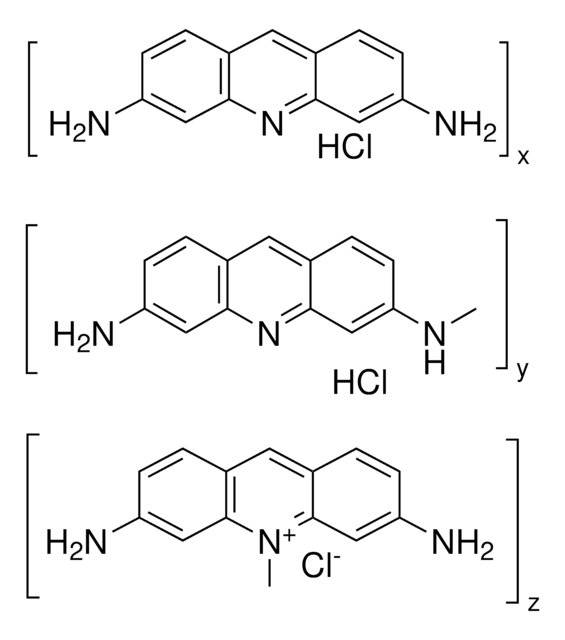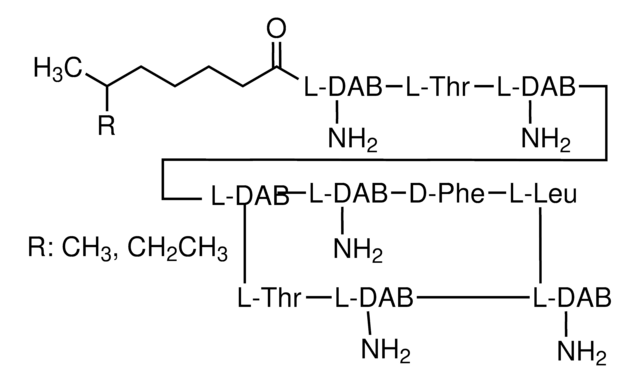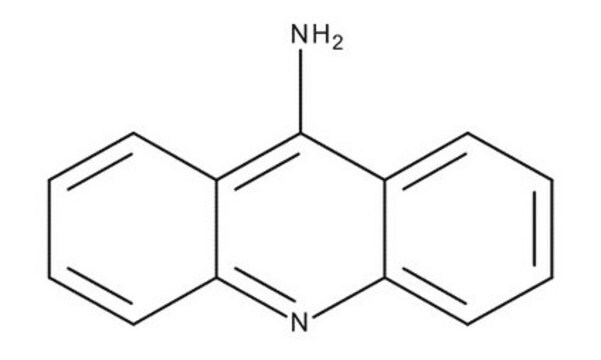A8251
Acriflavine hydrochloride
Powder
Synonyme(s) :
3,6-Diamino-10-methylacridinium chloride hydrochloride, Euflavine
About This Item
Produits recommandés
Nom du produit
Acriflavine hydrochloride, fluorescent dye
Niveau de qualité
Forme
powder
Composition
Acriflavine HCL content, 10-50%
Proflavine HCL, 25-70%
Technique(s)
microbe id | staining: suitable
Couleur
faint brown to brown, and Orange to Dark Orange and Red to Very Dark Red
Pf
260 °C (dec.) (lit.)
Solubilité
H2O: 1 mg/mL
Application(s)
diagnostic assay manufacturing
hematology
histology
Température de stockage
room temp
Chaîne SMILES
[Cl-].Cl[H].Cl[H].Nc1ccc2cc3ccc(N)cc3nc2c1.C[n+]4c5cc(N)ccc5cc6ccc(N)cc46
InChI
1S/C14H13N3.C13H11N3.3ClH/c1-17-13-7-11(15)4-2-9(13)6-10-3-5-12(16)8-14(10)17;14-10-3-1-8-5-9-2-4-11(15)7-13(9)16-12(8)6-10;;;/h2-8H,1H3,(H3,15,16);1-7H,14-15H2;3*1H
Clé InChI
MKLTXAHQKDVBLY-UHFFFAOYSA-N
Vous recherchez des produits similaires ? Visite Guide de comparaison des produits
Application
Actions biochimiques/physiologiques
Autres remarques
Mention d'avertissement
Danger
Mentions de danger
Conseils de prudence
Classification des risques
Acute Tox. 4 Oral - Aquatic Chronic 2 - Eye Dam. 1
Code de la classe de stockage
11 - Combustible Solids
Classe de danger pour l'eau (WGK)
WGK 2
Point d'éclair (°F)
Not applicable
Point d'éclair (°C)
Not applicable
Équipement de protection individuelle
dust mask type N95 (US), Eyeshields, Gloves
Faites votre choix parmi les versions les plus récentes :
Déjà en possession de ce produit ?
Retrouvez la documentation relative aux produits que vous avez récemment achetés dans la Bibliothèque de documents.
Les clients ont également consulté
Notre équipe de scientifiques dispose d'une expérience dans tous les secteurs de la recherche, notamment en sciences de la vie, science des matériaux, synthèse chimique, chromatographie, analyse et dans de nombreux autres domaines..
Contacter notre Service technique














